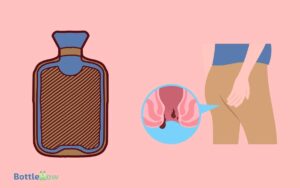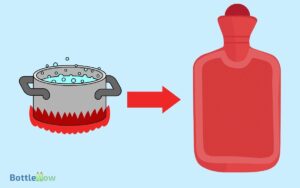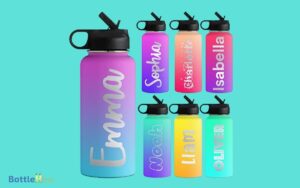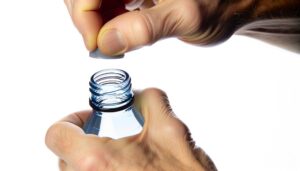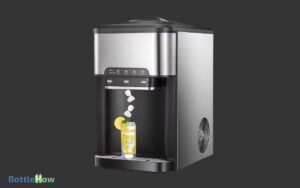Why Is There Black Stuff in My Water Bottle
The black stuff in your water bottle is likely mold, stemming from moisture and inadequate cleaning. Mold thrives in damp environments and can accumulate in hard-to-clean areas like rubber seals and bottle crevices.
Regular exposure to mold can cause respiratory problems and gastrointestinal issues. To prevent this, disassemble your bottle and clean it thoroughly with hot, soapy water, making certain to dry all parts completely.
Regular inspections and proper hygiene practices are crucial. Understanding the specifics of your bottle's material will further guarantee safe and effective cleaning strategies.
Keep going to uncover more essential prevention tips.
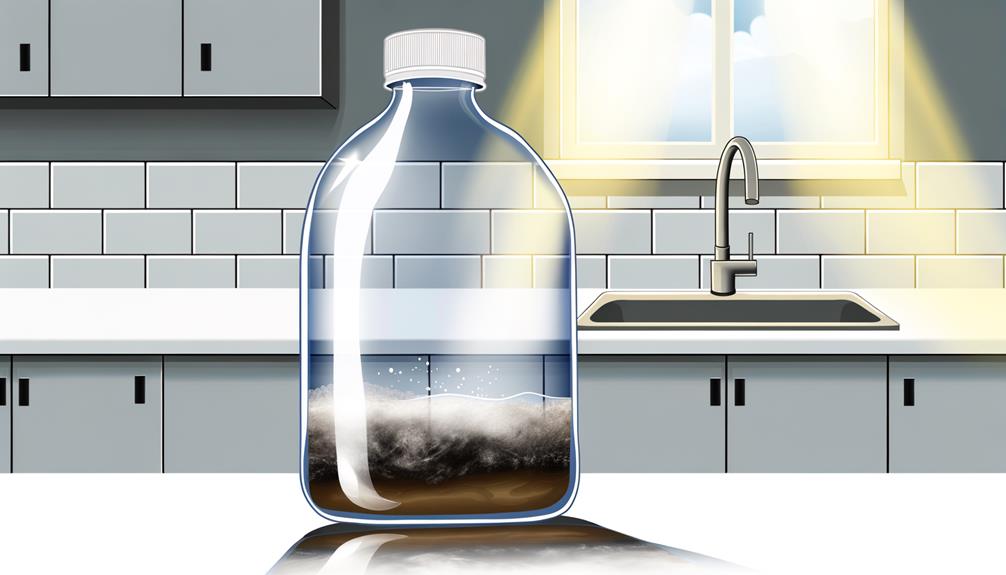
Key Takeaways
- Black residue often results from mold growth due to inadequate cleaning and drying practices.
- Moisture and organic materials in the bottle create ideal conditions for mold and bacterial contamination.
- Rubber seals and small crevices can trap moisture, promoting mold formation.
- Residual sugars and organic matter from beverages accelerate mold growth inside the bottle.
Common Causes
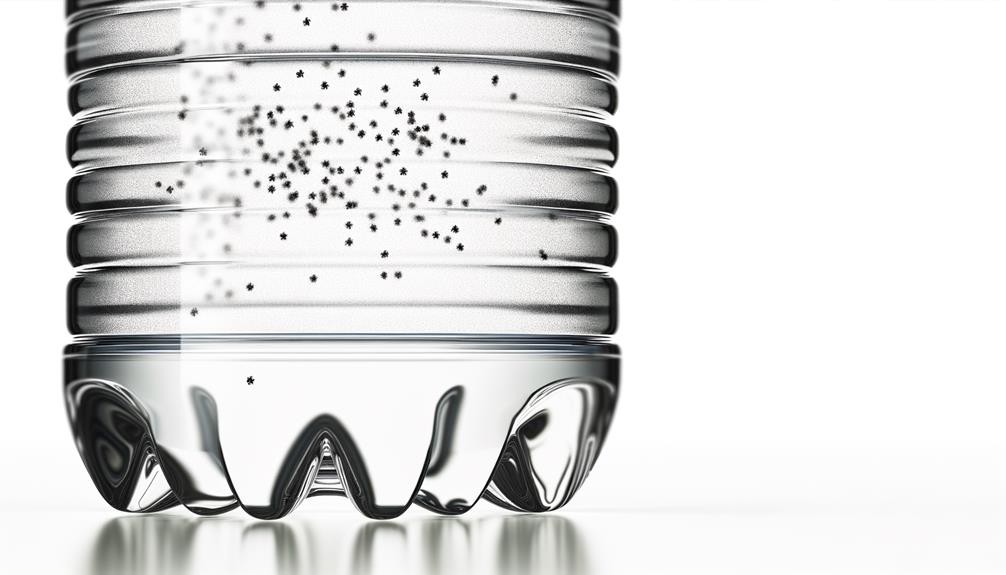
One common cause of black residue in your water bottle is the growth of mold due to inadequate cleaning.
When you don't clean your water bottle regularly, moisture and organic materials like sugars from beverages can create an ideal environment for mold. Mold spores are ubiquitous in the air and will settle into damp, nutrient-rich areas.
Over time, these spores multiply, forming the black residue you see. Even small crevices or the area around the bottle's cap can harbor mold if not properly sanitized.
To prevent this, make sure you wash your bottle thoroughly with hot, soapy water and let it dry completely. Regular cleaning disrupts mold's growth cycle, keeping your water bottle safe and hygienic.
Health Implications
You might be concerned about bacterial contamination, as these microorganisms can lead to significant health issues.
Additionally, the black stuff could indicate mold exposure, which poses respiratory risks.
Bacterial Contamination Risks
When bacterial contamination infiltrates your water bottle, it poses serious health risks including gastrointestinal infections and other illnesses. Harmful bacteria like E. coli, Salmonella, and Pseudomonas can thrive in moist environments, especially when residue accumulates. Ingesting these pathogens can lead to symptoms like diarrhea, nausea, and abdominal pain.
Additionally, bacterial biofilms can form on the inner surfaces of your bottle, making them hard to eliminate through simple rinsing.
To mitigate these risks, follow stringent hygiene practices. Clean your bottle daily with hot, soapy water, and use a bottle brush to reach crevices. Periodically disinfect using diluted bleach or vinegar solutions.
Proper sanitation not only guarantees your water stays safe but also extends the lifespan of your bottle.
Potential Mold Exposure
Just as bacteria pose significant health risks in your water bottle, mold exposure can also lead to serious medical issues, including respiratory problems and allergic reactions. Mold spores, when inhaled, can trigger asthma attacks, especially in those with pre-existing conditions.
Even if you're not asthmatic, prolonged exposure to mold can cause symptoms like coughing, sneezing, and nasal congestion. Mold also produces mycotoxins, which can irritate your respiratory system and skin.
Regularly cleaning your water bottle is vital to prevent mold growth. Use hot water and soap or a mild bleach solution to thoroughly clean all parts, including the cap and threads.
Always let the bottle dry completely before using it again to mitigate mold risks effectively.
Toxin Ingestion Concerns
Ingesting toxins from contaminated water bottles can lead to severe health complications, including gastrointestinal distress and long-term organ damage.
When you drink from a bottle with black residue, you risk consuming harmful bacteria, mold, or chemical contaminants. These substances can cause symptoms such as nausea, vomiting, diarrhea, and abdominal pain.
Over time, continuous exposure to these toxins may impair liver and kidney function, increasing the risk of chronic illnesses.
It's essential to regularly clean and inspect your water bottle to prevent these risks. If you notice any unusual discoloration or smell, stop using the bottle immediately and sanitize it thoroughly.
Staying vigilant helps protect your health and guarantees that your hydration source remains safe.
Mold and Mildew
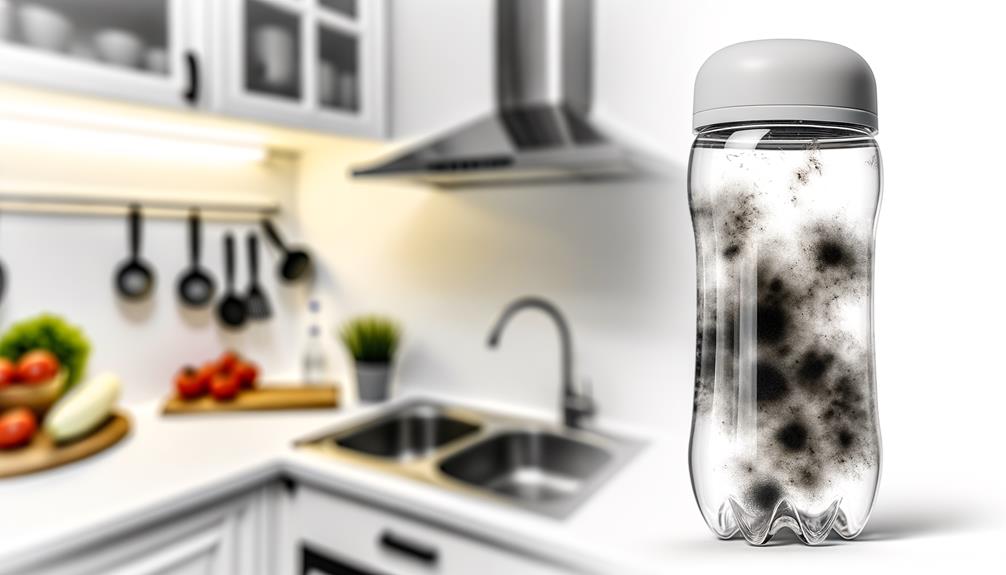
You might notice black stuff in your water bottle due to mold and mildew, which thrive in damp, dark environments.
These fungi pose significant health risks, including respiratory issues and allergic reactions.
Regular cleaning and proper drying can effectively prevent their growth and keep your bottle safe for use.
Causes of Mold Growth
Mold and mildew thrive in environments that are moist, warm, and poorly ventilated, making your water bottle a perfect breeding ground if not properly cleaned and dried.
Mold spores are omnipresent in the air, and when they land in a damp, nutrient-rich environment like your water bottle, they begin to grow. Residual sugars and organic materials from beverages can accelerate this process.
Additionally, inadequate cleaning techniques or infrequent washing allow these spores to multiply. Even the rubber seals and crevices of water bottles can trap moisture, creating micro-environments conducive to mold growth.
To mitigate this, verify you wash your bottle thoroughly with soap and hot water, and let it dry completely before reusing.
Health Risks Involved
Exposure to mold and mildew in your water bottle can lead to a variety of adverse health effects ranging from allergic reactions to respiratory issues.
When you ingest or inhale mold spores, your immune system can react, causing symptoms like sneezing, coughing, and itchy eyes.
For those with asthma or other respiratory conditions, the consequences can be more severe, including difficulty breathing and potential asthma attacks.
Mold exposure can also irritate your skin, leading to rashes or hives.
Prolonged exposure might even compromise your immune system, making you more susceptible to infections.
Given these risks, it's essential to understand the potential hazards and take immediate action to address any black substance in your water bottle.
Cleaning and Prevention
Ensuring your water bottle remains free of mold and mildew involves regular and thorough cleaning practices.
First, disassemble any removable parts like caps, straws, and seals. Use hot, soapy water and a bottle brush to scrub all surfaces, focusing on hard-to-reach areas. Rinse thoroughly to remove soap residue.
For deeper cleaning, soak the bottle in a solution of one tablespoon of baking soda per cup of water for 15 minutes. Alternatively, use white vinegar for its antifungal properties. After soaking, scrub and rinse again.
Dry all components completely before reassembling to prevent moisture buildup. Regularly inspect your bottle for any signs of mold, and don't forget to clean it daily to maintain a safe drinking environment.
Cleaning Techniques
To effectively eliminate the black residue in your water bottle, start by thoroughly disassembling all its parts. Use a bottle brush to scrub the interior, focusing on corners and crevices. Rinse each component with hot water to loosen buildup. Soak the parts in a solution of vinegar and water (1:1 ratio) for 15 minutes to break down any remaining debris. After soaking, scrub again and rinse thoroughly.
| Step | Action | Emotion |
|---|---|---|
| Disassemble | Separate all parts | Determination |
| Scrub | Clean with a brush | Satisfaction |
| Soak | Vinegar solution soak | Relief |
Dry the parts completely before reassembling to prevent future growth of black residue.
Material Breakdown
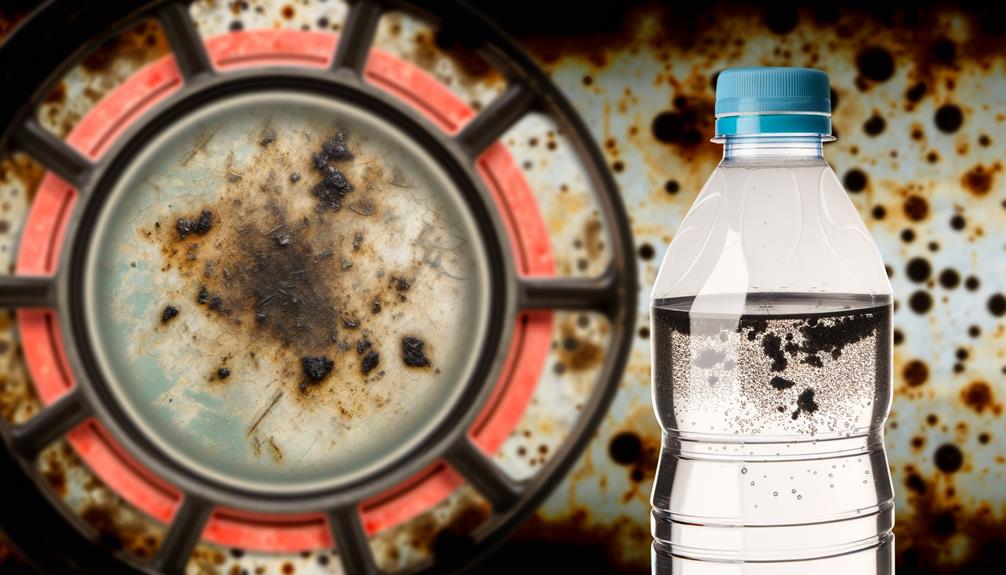
Understanding the materials your water bottle is made from can help you identify the source of the black residue and choose appropriate cleaning methods.
For instance, plastic bottles can degrade over time, releasing microscopic particles that accumulate as black residue. Stainless steel bottles may harbor mold or mildew if not dried properly, while aluminum bottles with coatings can break down, causing flakes to appear.
Silicone parts like gaskets and seals can also degrade, leading to discoloration. By recognizing these material-specific issues, you can better understand how the residue forms.
Regular inspection and proper maintenance tailored to your bottle's material can mitigate these problems. Always follow the manufacturer's guidelines for cleaning to guarantee longevity and safety.
Prevention Tips
Regular maintenance tailored to your bottle's material, along with a few strategic practices, can help prevent the formation of black residue in your water bottle.
For stainless steel bottles, wash with warm soapy water daily and use a bottle brush to reach crevices.
For plastic bottles, avoid using harsh chemicals; instead, clean with a mixture of vinegar and water. This natural solution helps remove residue and odors without damaging the material. Harsh cleaners can weaken the plastic over time, reducing the bottle’s durability. If you’re wondering, will bleach dissolve plastic bottles, it’s best to avoid using it regularly, as it may degrade certain types of plastic.
Always dry your bottle completely to prevent mold growth.
Store your bottle with the cap off to enhance airflow.
For bottles with straws or spouts, disassemble and clean each part thoroughly.
Adding a monthly deep-clean with baking soda can also be beneficial.
Conclusion
Think of your water bottle as a small ecosystem; neglect can turn it into a breeding ground for unwanted guests.
The black stuff symbolizes the hidden dangers of overlooking routine care. By understanding common causes, health risks, and effective cleaning techniques, you can guarantee your bottle remains safe and clean.
Don't let material breakdown or mold take root—regular maintenance is your best defense.
Keep your water bottle pristine, like a well-tended garden, and you'll reap the benefits of a healthier lifestyle.

